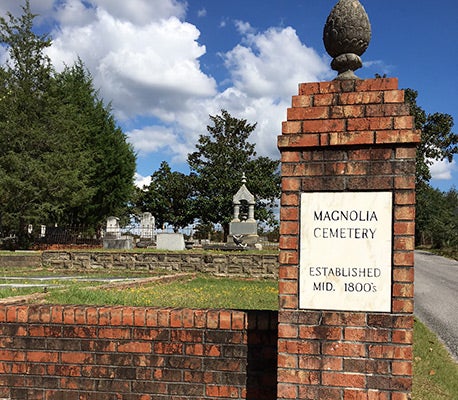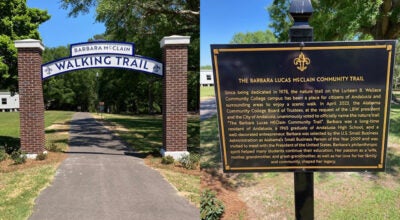Remember when: Stickers in cemeteries
Published 12:00 am Saturday, October 7, 2017
“Where have all the flowers gone, long time passing; where have all the flowers gone, long time ago; where have all the flowers gone, …gone to graveyards every one. When will they ever learn?”
One of my favorite folk songs from the 60s, the theme of this particular Peter, Paul, and Mary song was the tragedy of war. There are some soldier graves in Magnolia Cemetery as noted by Sidney and Polly Waits in their 1995 book, “An Index of Magnolia Cemetery, Andalusia, Alabama.” They list Confederate veterans and veterans of other wars buried in Magnolia including WWI, WWII, Korea, and Vietnam.
“Magnolia Cemetery is the oldest known cemetery in the City of Andalusia. The plaque on the entrance gate indicates it was opened in the mid-1800s. The founding fathers acquired the 40 acres that made up the original town of Andalusia, and they called for the construction of a courthouse on the land. They also reserved a space near the courthouse for a community church. Shortly after Andalusia was named the new county seat, a church was erected near the courthouse and a cemetery was subsequently begun directly behind the church. Magnolia Cemetery today is a quiet place nestled in the midst of a busy and noisy community. It is speckled with lovely old Southern Magnolia, Youpon, and Cedar trees, a distinctively beautiful cemetery.”
“Time has erased many of the early graves in the old cemetery. The elements caused many markers to decay beyond recognition, and many graves that had wooden markers have long since disappeared. “
The Waits also penned, “We have indexed the burials hoping you (the reader) will find your ancestors listed and this book will be of benefit to you in your research.”
Our hometown historic cemetery is full of beautiful “speaking” stones that tell us the stories of the past, of the people, who came before us and helped to build Andalusia. They are the links to our past. Those who abide there are the silent witnesses of what has gone on before. We owe thanks to those founding fathers and families and for the rich legacy they have left for us all.
Ride through Magnolia Cemetery and view the many names on the headstones that are our familiar street names – Stanley, Prestwood, Cawthon, Henderson, McDonald, O’Neal, McGowin, Pelham, Riley, Pugh, Powell, Shreve, Simmons, Robinson, Snowden, Waits, Thames, Bagley, Albritton, Adams, Baisden, Bonner, Brooks, Chapman, Dunson, Easley, Faulkenberry, Fletcher, Merrill, McArtan, Little, Ray, Carson, Burgess, Wilder, Doyle, Dixon, Burnett, Broughton, and Tisdale to name just a few. Just add “Street,” “Court,” “Drive,” “Avenue,” or “Circle” to any of the above, and, alas, you will discover Andalusia city street names!
In “The Historic Oakland Cemetery of Atlanta,” author Cathy J. Kaemmerlen writes, “Most of us grew up thinking cemeteries are the places to bury the dead. They are sad places, scary places, morbid places, places to avoid. Death is not something pleasant to linger over. It is not easy to accept finality. Now I realize that cemeteries
are places for the living, places to go and find connections with the past.”
Author of “Stories in Stone,” Douglas Keister writes, “Nowhere is the language of symbols more apparent than in cemeteries which are virtual encyclopedias of symbolism. Dead men may tell no tales, but their tombstones do. Besides informing us of names and dates of birth and death, tombstone symbols often tell us a person’s religion, ethnicity, social membership, occupation, and thoughts of the afterlife – crosses for Christians, six-pointed stars for Jews, hearts that speak of love, lambs for innocence, and circles for completeness and immortality. Cemetery enthusiasts know that cemeteries are a vast treasure trove of art and architecture.”
In “Alabama Cemeteries, A Guide to Their Stories in Stone,” Donna Jenkins Booth writes, “As I wandered among the graves of Alabama pioneers, I was deeply touched by their strength and courage in the face of devastating loss and hardship. I sincerely hope that more people will become interested in preserving our burial grounds so that future generations will be able to admire their beauty and discover our heritage.”
The late Jack and Olivia Solomon of Tallassee wrote in their book, “Gone Home,” “Except for isolated instances, the gradual disappearance of the epitaph was mostly complete by 1950. To document its decline and death is to raise some important questions about modern man in the Western world. An explanation of sorts lies in the hand of technology. Mass production displaced thousands of craftsmen who might have expended months to ornament, sculpt, and inscribe a single stone. The machine item could be replicated quickly and cheaply like a “store bought” dress or suit.”
Many epitaphs from Magnolia Cemetery are hard to read because of years of weathering. So I carried my chalk (not shaving cream) around as I walked through Magnolia on the beautiful fall day trudging through ankle-deep grass in some plots and lots of stickers that begged to leave their mark of remembrance on my canvas shoes and the hems of my pants.
“Gone But Not Forgotten” is a folk phrase that has won its immortality by the hundreds of thousands according to some cemetery enthusiasts, and, sure enough, I spied that epitaph more than once in our “hallowed ground atop the Devereux.”
“Rest mother, rest in gentle sleep while friends in sorrow o’er thee weep” is a touching epitaph in Magnolia along with “She was far too sweet to linger long.”
Other heartfelt epitaphs I found that are tributes to mother, sister, wife, or child include “Mother/Baby,” “As a star that’s lost when the daylight is given, She has faded away to shine brightly in heaven,” “Thou art gone little darling, Sweet child of our love, From earth’s fairy strand to bright mansions above,” and “Without thee, what is all the morning’s wealth.”
“He was faithful to every duty” was inscribed on a diligent gentleman’s headstone.
“With Jesus” was noted on every family member’s grave in one particular plot. “Asleep in Jesus, Blessed Thought” is a memorable epitaph which inscription lasted on another headstone in the peaceful setting for many years.
Other emblems mark certain graves such as Masonic Orders, Knights of Pythias, Daughters of the American Revolution, Colonial Dames, Purple Heart, Woodman of the World, and Eastern Star.
Somewhere I once read, “Remember Me” is the wish of all mankind. From Hamlet, “From royalty to common man, all want to be remembered.”
From the old newspapers, I read that the funeral pall bearers would walk the casket over about two blocks from the Methodist Church once located on Church Street, the present site of the Evers Building across the street from the fire department. I am certain that the same is true of the funerals held at the Baptist Church once located in the present courthouse rear parking lot just south of the cemetery entrance at the Crescent Street/ O’Neal Court junction.
Through the years, the City of Andalusia has made significant attempts to upkeep and maintain Magnolia along with other cemeteries within the city, Andalusia Memorial and Marshall Memorial. Without their assistance, Magnolia which contains much of our older town history would not be what it is today.
“The earliest grave visible today,” according to the Waits “is 1855, but it is reasonable to assume that there are many graves much earlier since the little village of Andalusia was born in 1844.”
“People from all walks of life dot its surface including horse traders, bankers, doctors, lawyers, postmasters, mayors, automobile dealers, restaurateurs, businessmen, homemakers, builders, judges, and veterans of wars.”
“Most of the early records have been lost over time. Probably a few families have their original deeds to lots. There is no known plat of old Magnolia although there are plats and lot information on the two additions that have been added to the original Magnolia in 1926 and 1938. It is surprising how many graves are not marked. Grass and soil have long since covered any evidence of a grave.”
Many thanks go to Sidney Waits and the late Polly Wilder Waits for the information in this column and quotes which were obtained from their book which can be found at the Andalusia Public Library and used as a reference guide for research. In talking with Mr. Sid on the telephone today, we agreed that this fall season of the year might be a good time to issue a call to the citizens for a “cemetery clean-up day” to be held to do a little limb trimming and vine removal, weed eating, mowing, edging, raking, and tending, in general, to Magnolia with the City’s permission and assistance, of course. So please, citizens and families of those “gone home” and resting in Magnolia Cemetery, be on the look-out for a notice of that event.
I do not REMEMBER WHEN my great grandparents, Brunson and Mathis, were buried at Magnolia Cemetery, because the dates were 1930, 1943, 1948. However, I do remember a 1956 burial date of a great uncle interred at Magnolia that was the first funeral visitation I ever attended at age nine. It was set in the old Foreman Funeral Home location on South Three Notch Street where Merle and Henry Edward Jones’ Town and Country later operated their ladies’ apparel store for many years and where St. Michael’s Anglican Church now worships.
Sue Bass Wilson is a local real estate broker and long-time member of the Covington Historical Society. She can be reached at suebwilson@andycable.com.






